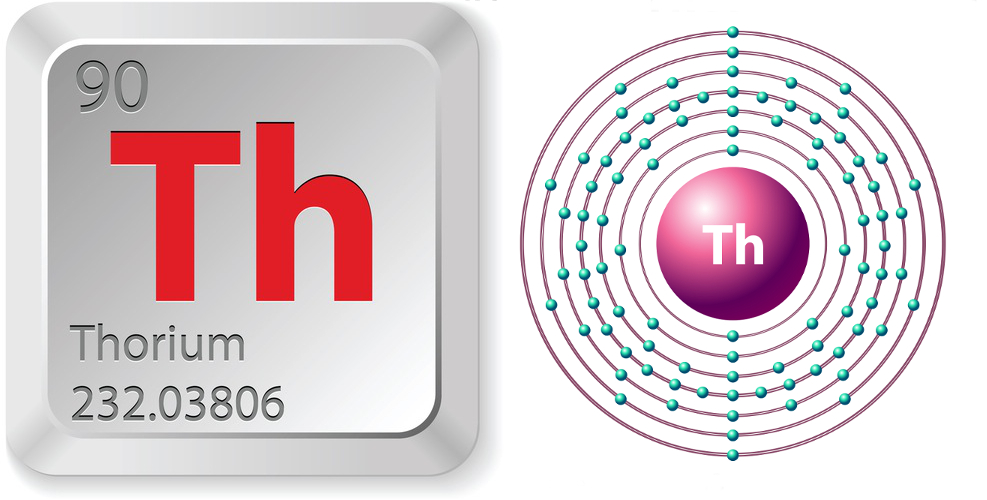Facts About Thorium

Named for the Norse god of thunder, thorium is a silvery, lustrous and radioactive element with potential as an alternative to uranium in fueling nuclear reactors.
Just the facts
- Atomic number (number of protons in the nucleus): 90
- Atomic symbol (on the Periodic Table of Elements): Th
- Atomic weight (average mass of the atom): 232.0
- Density: 6.8 ounces per cubic inch (11.7 grams per cubic cm)
- Phase at room temperature: Solid
- Melting point: 3,182 degrees Fahrenheit (1,750 degrees Celsius)
- Boiling point: 8,654 F (4,790 C)
- Number of natural isotopes (atoms of the same element with a different number of neutrons): 1. There are also at least 8 radioactive isotopes created in a lab.
- Most common isotopes: Th-232 (100 percent of natural abundance)
History
In 1815, Jöns Jakob Berzelius, a Swedish chemist, first thought he had discovered a new Earth element, which he named thorium after Thor, the Norse god of war, according to Peter van der Krogt, a Dutch historian. In 1824, however, it was determined that the mineral was in fact yttrium phosphate.;
In 1828, Berzelius received a sample of a black mineral found on Løvø Island off the coast of Norway by Hans Morten Thrane Esmark, a Norwegian mineralogist. The mineral contained nearly 60 percent of an unknown element, which took over the name thorium; the mineral was named thorite. The mineral also contained many known elements, including iron, manganese, lead, tin, and uranium, according to Chemicool.
Berzelius isolated thorium by first mixing thorium oxide found in the mineral with carbon to create thorium chloride, which was then reacted with potassium to yield thorium and potassium chloride, according to Chemicool.
Gerhard Schmidt, a German chemist, and Marie Curie, a Polish physicist, independently discovered that thorium was radioactive in 1898 within a couple months of each other, according to Chemicool. Schmidt is often credited with the discovery.
Ernest Rutherford, a New Zealand physicist, and Frederick Soddy, an English chemist, discovered that thorium decays at a fixed rate into other elements, also known as the half-life of an element, according to Los Alamos National Laboratory. This work was critical in furthering the understanding of other radioactive elements.
Anton Eduard van Arkel and Jan Handrik de Boer, both Dutch chemists, isolated high purity metalic thorium in 1925, according to Los Alamos National Laboratory.
Get the world’s most fascinating discoveries delivered straight to your inbox.
Who knew?
- In its liquid state, thorium has a greater temperature range than any other element, with nearly 5,500 degrees Fahrenheit (3,000 degrees Celsius) between melting and boiling points, according to Chemicool.
- Thorium dioxide has the highest melting point of all known oxides, according to Chemicool.
- Thorium is about as abundant as lead and at least three times as abundant as uranium, according to Lenntech.
- The abundance of thorium in Earth's crust is 6 parts per million by weight, according to Chemicool. According to Periodic Table, thorium is the 41st most abundant element in Earth's crust.
- Thorium is mainly mined in Australia, Canada, the United States, Russia and India, according to Minerals Education Coalition.
- Trace levels of thorium are found in rocks, soil, water, plants and animals, according to the U.S. Environmental Protection Agency (EPA).
- Higher concentrations of thorium are typically found in minerals such as thorite, thorianite, monazite, allanite, and zircon, according to Los Alamos National Laboratory.
- The most stable isotope of thorium, Th-232, has a half-life of 14 billion years, according to the EPA.
- According to Los Alamos, thorium is created in the cores of supernovae and then scattered across the galaxy during the explosions.
- Thorium had been used since 1885 in gas mantles, which provide the light in gas lamps, according to Los Alamos. Due to its radioactivity, the element has been replaced by other nonradioactive rare-earth elements.
- Thorium is also used to strengthen magnesium, coating tungsten wire in electrical equipment, controlling the grain size of tungsten in electric lamps, high-temperature crucibles, in glasses, in camera and scientific instrument lenses, and is a source of nuclear power, according to Los Alamos.
- Other uses for thorium include heat-resistant ceramics, aircraft engines, and in light bulbs, according to Chemicool.
- According to Lenntech, thorium was used in toothpaste until radioactivity dangers were discovered.
- Thorium and uranium are involved in the heating of Earth's interior, according to Minerals Education Coalition.
- Too much thorium exposure can cause lead to lung disease, lung and pancreatic cancer, alter genetics, liver disease, bone cancer, and metal poisoning, according to Lenntech.
Current research
A great deal of research is going into using thorium as a nuclear fuel. According to an article from the Royal Society of Chemistry, thorium used in nuclear reactors provide many benefits over using uranium:
- Thorium is three to four times more abundant than uranium.
- Thorium is more easily extracted than uranium.
- Liquid fluoride thorium reactors (LFTR) have very little waste compared with reactors powered by uranium.
- LFTRs run at atmospheric pressure instead of 150 to 160 times atmospheric pressure currently needed.
- Thorium is less radioactive than uranium.
According to a 2009 paper by NASA researchers Albert J. Juhasz, Richard A. Rarick, and Rajmohan Rangarajan, thorium reactors were developed at the Oak Ridge National Laboratory in the 1950s under the direction of Alvin Weinberg for supporting nuclear aircraft programs. The program stopped in 1961 in favor of other technologies. According to the Royal Society of Chemistry, thorium reactors were abandoned because they did not produce as much plutonium as uranium-powered reactors. At that time, weapons-grade plutonium, as well as uranium, was a hot commodity due to the Cold War.
Thorium itself is not used for nuclear fuel, but it is used to create the artificial uranium isotope uranium-233, according to the NASA report. Thorium-232 first absorbs a neutron, creating thorium-233, which decays to protactium-233 over the course of about four hours. Protactium-233 slowly decays to uranium-233 over the course of about ten months. Uranium-233 is then used in nuclear reactors as fuel.
Additional resources

Rachel Ross is a science writer and editor focusing on astronomy, Earth science, physical science and math. She holds a Bachelor of Arts in Philosophy from the University of California Davis and a Master's degree in astronomy from James Cook University. She also has a certificate in science writing from Stanford University. Prior to becoming a science writer, Rachel worked at the Las Cumbres Observatory in California, where she specialized in education and outreach, supplemented with science research and telescope operations. While studying for her undergraduate degree, Rachel also taught an introduction to astronomy lab and worked with a research astronomer.



